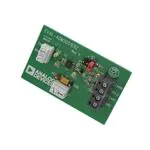Evaluation Board User Guide
UG-330
One Technology Way • P.O. Box 9106 • Norwood, MA 02062-9106, U.S.A. • Tel: 781.329.4700 • Fax: 781.461.3113 • www.analog.com
Evaluation Board for the ADM3051 CAN Transceiver
FEATURES
EVAL-ADM3051EBZ
10248-001
Easy evaluation of the ADM3051 controller area network
(CAN) transceiver
Convenient connections for power and logic signals through
screw terminal blocks
Screw terminal block for bus cable signals and shield
Test points for measuring all signals
Configure operating mode using jumper connection
High speed
Slope control
Standby
Slope control resistor of 47 kΩ fitted by default
Termination resistors (2 × 30 Ω) with common-mode filter
Figure 1.
EVALUATION KIT CONTENTS
EVAL-ADM3051EBZ
GENERAL DESCRIPTION
The EVAL-ADM3051EBZ allows quick and easy evaluation of the
ADM3051 CAN transceiver. The evaluation board allows all of
the input and output functions to be exercised without the need
for external components. Screw terminal blocks provide convenient
connections for logic signals and power.
The main device on the evaluation board, the ADM3051, is a
controller area network (CAN) physical layer transceiver,
allowing a protocol layer CAN controller to access the physical
layer bus. The ADM3051 complies with the ISO 11898
standard. It is capable of running at data rates of up to 1 Mbps.
For evaluation with a bus cable, a screw terminal block is
provided to allow connection of CANH and CANL signals and
connection of the cable shield.
PLEASE SEE THE LAST PAGE FOR AN IMPORTANT
WARNING AND LEGAL TERMS AND CONDITIONS.
The operating mode of the ADM3051 can be selected by
jumper configuration. Three operating modes are available:
high speed, slope control, and standby. Selecting standby mode
connects Pin 8 (RS) of the ADM3051 to VCC, placing the device
in a low current standby mode. Selecting slope control mode
limits EMI by connecting RS with a 47 kΩ resistor to ground to
modify the rise and fall of slopes. This mode facilitates the use
of unshielded cables. Alternatively, selecting high speed mode
disables slope control by connecting RS to ground, allowing
high speed operation. Shielded cables or other measures to
control EMI are necessary in this mode.
Rev. 0 | Page 1 of 8
�UG-330
Evaluation Board User Guide
TABLE OF CONTENTS
Features .............................................................................................. 1
Operating Modes ...........................................................................3
Evaluation Kit Contents ................................................................... 1
Evaluation .......................................................................................3
EVAL-ADM3051EBZ ....................................................................... 1
Evaluation Board Schematic and Layout........................................4
General Description ......................................................................... 1
Ordering Information .......................................................................6
Revision History ............................................................................... 2
Bill of Materials ..............................................................................6
Evaluation Board Configuration .................................................... 3
Related Links ..................................................................................6
Setting Up the Evaluation Board ................................................ 3
REVISION HISTORY
11/11—Revision 0: Initial Version
Rev. 0 | Page 2 of 8
�Evaluation Board User Guide
UG-330
EVALUATION BOARD CONFIGURATION
SETTING UP THE EVALUATION BOARD
EVALUATION
The EVAL-ADM3051EBZ allows the ADM3051 CAN
transceiver to be evaluated quickly and easily. The evaluation
board allows all of the input and output functions to be exercised
without the need for external components.
An example operation of the EVAL-ADM3051EBZ is shown
in Figure 2. Ensure that LK3 is in Position B (high speed mode).
Connect a clock generator on TxD and set up a 500 kHz square
wave clock with output swing between 0 V and 5 V. Connect the
scope probes to the CANH and CANL test points. A plot of the
oscilloscope for TxD, RxD, CANH, and CANL is shown in
Figure 3. Channel 1 shows the TxD signal, Channel 4 shows the
RxD signal, and Channel 2 and Channel 3 show the CANH and
CANL signals, respectively.
On the EVAL-ADM3051EBZ, the power is connected to VCC.
A 22 µF decoupling capacitor, C1, is fitted between VCC and
GND at the J1 board connector, and a 100 nF capacitor (C2 in
Figure 4) is fitted at the ADM3051 device. With the default 60 Ω
load installed, the typical supply current (ICC) is as follows:
•
•
•
Recessive state: 5 mA
Clock at 1 Mbps: 40 mA
Clock at 250 kbps (slope control mode): 34 mA
In standby, with the bus in a recessive state, typical ICC is
很抱歉,暂时无法提供与“EVAL-ADM3051EBZ”相匹配的价格&库存,您可以联系我们找货
免费人工找货